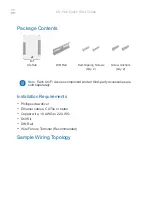
• If the bus communication problems are severe and no communication is present or you
cannot determine where communication is unreliable, partition (disconnect and isolate) a
portion of the bus and test the bus portion connected to the Zone Coordinator.
Correcting physical communication bus problems
The communication bus is subject to a number of physical factors that can affect performance. Use
the following list to check and correct common physical problems that affect the communications
bus:
• Check the status LED to verify that the controller has power.
• Check the wires for the following:
- Verify that the wire is a 22 AWG (0.6 mm) three-conductor, twisted, shielded cable.
- Verify that the shield is continuous and hard-grounded at one end.
• Check the wiring:
- Check for and eliminate T-taps, wire configurations that create a T shape, and star
configurations.
- Ensure that the bus is wired in a daisy-chain configuration.
- Verify that the appropriate devices have two wires entering and exiting each terminal.
Note:
Devices at the ends of the trunk have one wire entering and exiting each
terminal.
• Check EOL switch settings:
- Verify that the zone bus EOL switch on the Zone Coordinator is set to
ON
and the Zone
Coordinator is located at the end of the zone bus trunk.
- Verify that only the EOL switch at the end of the zone bus is set to
ON
and all other zone
bus EOL switches are set to off.
• Check connections, polarity, and lengths:
- Verify that communications loops are less than 1,000 ft (304 m) total in length.
- If you are using one transformer to power multiple devices, verify that the device 24 VAC
power connection follows the polarity of the common and 24 V terminations (see
and zone bus supply power wiring guidelines
• Check for opens and short circuits.
• Check terminations.
• Check for sources of interference.
• Check the following bus voltages:
• (+) to
COM
must be within 2.0 VDC to 3.0 VDC
• (-) to
COM
must be within 1.5 VDC to 2.54 VDC
• (+) to (-) must be within 0.3 VDC to 1.0 VDC
Note:
Values can fluctuate due to ongoing communications; this operation is normal
when the voltage is within the defined range.
Verasys ZEC510 VAV Controllers Installation Guide
30





































